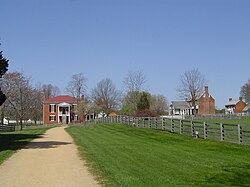Appomattox Court House National Historical Park
|
Appomattox Court House National Historical Park
|
|

Appomattox Court House National Historical Park. The Old Appomattox Court House is at left; the McLean House, the site of the surrender conference is at right.
|
|
| Location | Appomattox County, Virginia |
|---|---|
| Nearest city | Appomattox, Virginia |
| Coordinates | 37°22′39″N 78°47′45.6″W / 37.37750°N 78.796000°WCoordinates: 37°22′39″N 78°47′45.6″W / 37.37750°N 78.796000°W |
| Area | 1,774 acres (718 ha) |
| Built | 1865 |
| Visitation | 176,040 (2011) |
| Website | Appomattox Court House National Historical Park |
| NRHP Reference # | 66000827 |
| VLR # | 006-0033 |
| Significant dates | |
| Added to NRHP | October 15, 1966 |
| Designated VLR | July 6, 1971 |
|
|
The Appomattox Court House National Historical Park is a National Historical Park of original and reconstructed 19th century buildings in Appomattox County, Virginia. The village is famous as the site of the Battle of Appomattox Court House and containing the house of Wilmer McLean, where the surrender of the Confederate army under Robert E. Lee to Union commander Ulysses S. Grant took place on April 9, 1865, effectively ending the American Civil War. The McLean House was the site of the surrender conference, but the village itself is named for the presence nearby of what is now preserved as the Old Appomattox Court House.
The park was established August 3, 1935. The village was made a national monument in 1940 and a national historical park in 1954. It is located about three miles (5 km) east of Appomattox, Virginia, the location of the Appomattox Station and the "new" Appomattox Court House. It is in the center of the state about 25 miles (40 km) east of Lynchburg, Virginia.The historical park was described in 1989 as having an area of 1,325 acres (536 ha).
The antebellum village started out as "Clover Hill" named after its oldest existing structure, the Clover Hill Tavern (c. 1819). The village was a stagecoach stop along the Richmond-Lynchburg stage road. The activity in Clover Hill centered around Clover Hill Tavern. The tavern provided lodging to travelers. Fresh horses for the stage line were also provided at the stop, which had been done since the tavern was built. It was also the site of organizational meetings and so when Appomattox County was established by an Act on February 8, 1845, Clover Hill village became the county seat. It was parts of Buckingham, Prince Edward, Charlotte, and Campbell Counties. The jurisdiction took its name from the headwaters that emanate there, the Appomattox River. Early Virginians believe the name Appomattox came from an Indian tribe called Apumetec.
...
Wikipedia

